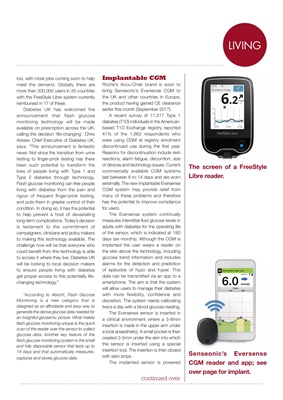
KITLIVING
Senseonic's Eversense
CGM reader and app.
The screen of a FreeStyle
Libre reader.
health economies to get it on formularies.
The focus is people with diabetes who
are intensively-using insulin. However,
it may take some time to get listed and
make its way onto local health economy
formularies."
The FreeStyle Libre system is made
in the UK, so it's a great export story
too, with more jobs coming soon to help
meet the demand. Globally there are
more than 300,000 users in 35 countries
with the FreeStyle Libre system currently
reimbursed in 17 of these.
Diabetes UK has welcomed the
announcement that flash glucose
monitoring technology will be made
available on prescription across the UK,
calling the decision 'life-changing'. Chris
Askew, Chief Executive of Diabetes UK,
says: "This announcement is fantastic
news: Not since the transition from urine
testing to finger-prick testing has there
been such potential to transform the
lives of people living with Type 1 and
Type 2 diabetes through technology.
Flash glucose monitoring can free people
living with diabetes from the pain and
rigour of frequent finger-prick testing,
and puts them in greater control of their
condition. In doing so, it has the potential
to help prevent a host of devastating
long-term complications. Today's decision
is testament to the commitment of
campaigners, clinicians and policy makers
to making this technology available. The
challenge now will be that everyone who
could benefit from this technology is able
to access it where they live; Diabetes UK
will be looking to local decision makers
to ensure people living with diabetes
get proper access to this potentially lifechanging technology."
*According to Abbott, Flash Glucose
Monitoring is a new category that is
designed as an affordable and easy way to
generate the dense glucose data needed
for an insightful glycaemic picture. What
makes flash glucose monitoring unique
is the quick scan of the reader over the
sensor to collect glucose data. Another
key feature of the flash glucose monitoring
system is the small and fully disposable
sensor that lasts up to 14 days and that
automatically measures, captures and
stores glucose data.
Implantable CGM
Roche's Accu-Chek brand is soon to
bring Senseonic's Eversense CGM to
the UK and other countries in Europe,
the product having gained CE clearance
earlier this month (September 2017).
A recent survey of 17,317 Type 1
diabetes (T1D) individuals in the Americanbased T1D Exchange registry
reported
41% of the 1,662 respondents who
were using CGM at registry enrolment
discontinued use during the first year.
Reasons for discontinuation include skin
reactions, alarm fatigue, discomfort, size
of devices and technology issues. Current
commercially available CGM systems
last between 6 to 14 days and are worn
externally. The new implantable Eversense
CGM system may provide relief from
many of these problems and therefore
has the potential to improve compliance
for users.
The Eversense system continually
measures interstitial fluid glucose levels in
adults with diabetes for the operating life
of the sensor, which is indicated at 180
days (six months). Although the CGM is
implanted the uses wears a reader on
the skin above the technology, including
glucose trend information and includes
alarms for the detection and prediction
of episodes of hypo and hyper. This
data can be transmitted via an app to a
smartphone. The aim is that the system
will allow users to manage their diabetes
with more flexibility, confidence and
discretion. The system needs calibrating
twice a day with a blood glucose reading.
The Eversense sensor is inserted in
a clinical environment where a 5-8 mm
insertion is made in the upper arm under
a local anaesthetic). A small pocket is then
continued over